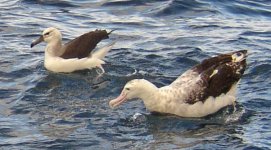
Is the bird on the left an immature Black-browed Albatross, or could it be some other species?
I believe the bird on the right is a Gibson's Albatross (Diomedea gibsoni), now split from Wandering Albatross (Diomedea exulans).
Corrections welcome.
27 August 2005, Tasman Sea off Wollongong, NSW, Australia.
Thanks.
I believe the bird on the right is a Gibson's Albatross (Diomedea gibsoni), now split from Wandering Albatross (Diomedea exulans).
Corrections welcome.
27 August 2005, Tasman Sea off Wollongong, NSW, Australia.
Thanks.




